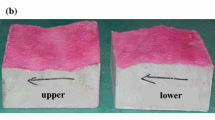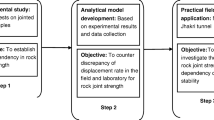Abstract
This study examined the shear behavior of rock joints and proposed an analytical model for estimating the shear strength at rock joints. Numerous experimental tests indicated that the shear behavior at rock joint depends on many factors including the distribution of initial joint asperity, asperity angle and strength, applied normal stress, and progressive degradation of asperity. Nevertheless, most pre-existing strength models do not consider these features on shearing at rock joints enough. In this study an improved shear strength model, which can consider the complex joint shearing features observed from many experimental tests, was developed and proposed. The improved model considers the joint features more reliably and overcomes the limitations of the pre-existing strength models. The proposed model was compared with some experimental test results along with some pre-existing strength models. The comparison clearly indicated that the improved model can estimate the shear strength at rock joints more reliably than the pre-existing models. From the study results it is expected that a better estimate of joint shear strength could be obtained in the future for various rock, joint, stress, and shearing conditions.
Similar content being viewed by others
References
Asadi MS, Rasouli V (2012) Physical simulation of asperity degradation using laboratorial shear tests of artificial fractures. Proceedings of 7 EUROCK 2012, the 2012 ISRM international symposium: Rock engineering and technology for sustainable underground construction, May 28–30, Stockholm, Sweden, 14
Barton N (1973) Review of a new shear strength criterion for rock joints. Engineering Geology 7(4):287–332, DOI: https://doi.org/10.1016/0013-7952(73)90013-6
Barton N (1976) The shear strength of rock and rock joints. International Journal of Rock Mechanics and Mining Sciences & Geomechanics Abstracts 13(9):255–279, DOI: https://doi.org/10.1016/0148-9062(76)90003-6
Barton N, Bandis S (1982) Effects of block size on the shear behaviour of jointed rock. The 23rd US symposium on rock mechanics (USRMS), August 25–27, Berkeley, CA, USA, 739–760
Barton N, Choubey V (1977) The shear strength of rock joints in theory and practice. Rock Mechanics and Rock Engineering 10(1–2):1–65, DOI: https://doi.org/10.1007/BF01261801
Belem T, Mountaka S, Homand F (2004) Generalized directional peak shear stress criterion for dilatant rock joints. 57th Canadian geotechnical conference, October 24–26, Quebec, Canada, 1–8
Ghazvinian AH, Taghichian A, Hashemi M, Marashi SA (2010) The shear behavior of bedding planes of weakness between two different rock types with high strength difference. Rock Mechanics and Rock Engineering 43(1):69–87, DOI: https://doi.org/10.1007/s00603-009-0030-8
Goldstein M, Goosev B, Pyrogovsky N, Tulinov R, Turovskaya A (1966) Investigation of mechanical properties of cracked rock. Proceedings of 1st ISRM congress, September 25–October 1, Lisbon, Portugal, 521–524
Grasselli G (2001) Shear strength of rock joints based on quantified surface description. PhD Thesis, Univeristá di Parma, Parma, Italy
Grasselli G, Egger P (2003) Constitutive law for the shear strength of rock joints based on three-dimensional surface parameters. International Journal of Rock Mechanics and Mining Sciences 40(1):25–40, DOI: https://doi.org/10.1016/S1365-1609(02)00101-6
Haberfield CM, Johnston IW (1994) A mechanistically-based model for rough rock joint. International Journal of Rock Mechanics and Mining Sciences and Geomechanics Abstracts 31(4):279–292, DOI: https://doi.org/10.1016/0148-9062(94)90898-2
Huang TH, Doong YS (1990) Anisotropic shear strength of rock joints. Proceedings of the international symposium on rock joints, June 4–6, Loen, Norway, 211–218
Jaeger JC (1971) Friction of rocks and the stability of rock slopes. Geotechnique 21(2):97–134, DOI: https://doi.org/10.1680/geot.1971.21.2.97
Jiang Y, Li B, Tanabashi Y (2006) Estimating the relation between surface roughness and mechanical properties of rock joints. International Journal of Rock Mechanics and Mining Sciences 43(6):837–846, DOI: https://doi.org/10.1016/j.ijrmms.2005.11.013
Jing L (1990) Numerical modeling of jointed rock masses by distinct element method for two, and three-dimensional problems. PhD Thesis, Lulea University of Technology, Lulea, Sweden
Jing L, Nordlund E, Stephansson O (1992) An experimental study on the anisotropy and stress-dependency of the strength and deformability of rock joints. International Journal of Rock Mechanics and Mining Sciences & Geomechanics Abstracts 29(6):565–542, DOI: https://doi.org/10.1016/0148-9062(92)91611-8
Johnston IW, Lam TSK (1989) Shear behavior of regular triangular concrete/rock joints analysis. Journal of Geotechnical Engineering 115(5):711–727, DOI: https://doi.org/10.1061/(ASCE)0733-9410(1989)115:5(711)
Kim DY, Lee YN (2007) New peak shear strength criteria for anisotropic rock joints using quantified joint roughness parameters. 11th congress of the international society for rock mechanics, July 9–13, Lisbon, Portugal, 355–358
Kulatilake PHSW, Balasingam P, Park J, Morgan R (2006) Natural rock joint roughness quantification through fractal techniques. Geotechnical & Geological Engineering 24(5):1181–1202
Kulatilake PHSW, Shou G, Huang TH, Morgan RM (1995) New peak shear strength criteria for anisotropic rock joints. International Journal of Rock Mechanics and Mining Sciences & Geomechanics Abstracts 32(7):673–697, DOI: https://doi.org/10.1016/0148-9062(95)00022-9
Ladanyi B, Archambault G (1970) Simulation of the shear behavior of a jointed rock mass. The 11th US symposium on rock mechanics (USRMS), June 16–19, Berkeley, CA, USA, 105–125
Lee S-W, Hong E-S, Bae S-I, Lee I-M (2006) Modelling of rock joint shear strength using surface roughness parameter, R. Tunnelling and Underground Space Technology 21(3–4)
Lee Y-K, Park J-W, Song J-J (2014) Model for the shear behavior of rock joints under CNL and CNS conditions. International Journal of Rock Mechanics and Mining Sciences 70(9):252–263, DOI: https://doi.org/10.1016/j.ijrmms.2014.05.005
Maksimovic M (1996) The shear strength components of a rough rock joint. International Journal of Rock Mechanics and Mining Sciences & Geomechanics Abstracts 33(8):769–783, DOI: https://doi.org/10.1016/0148-9062(95)00005-4
Newland PL, Allely BH (1957) Volume changes in drained triaxial tests on granular materials. Geotechnique 7(1):17–34, DOI: https://doi.org/10.1680/geot.1957.7.1.17
Oh J (2005) Three dimensional numerical modeling of excavation in rock with dilatant joints. PhD Thesis, University of Illinois at Urbana-Champaign, Champaign, IL, USA
Patton FD (1966) Multiple modes of shear failure in rock. Proceedings of the 1st congress of international society for rock mechanics, September 25–October 1, Lisbon, Portugal, 509–513
Plesha ME (1987) Constitutive models for rock discontinuities with dilatancy and surface degradation. International Journal for Numerical and Analytical Methods in Geomechanics 11(4):345–362, DOI: https://doi.org/10.1002/nag.1610110404
Reeves MJ (1985) Rock surface roughness and frictional strength. International Journal of Rock Mechanics and Mining Sciences & Geomechanics Abstracts 22(6):429–442, DOI: https://doi.org/10.1016/0148-9062(85)90007-5
Rowe PW, Barden I, Lee IK (1964) Energy components during the triaxial cell and direct shear tests. Geotechnique 14(3):247–261, DOI: https://doi.org/10.1680/geot.1964.14.3.247
Saeb S (1990) A variance on the Ladanyi and Archambault’s shear strength criterion. International symposium of rock joints, June 4–6, Loen, Norway, 701–705
Schneider HJ (1976) The friction and deformation behavior of rock joints. Rock Mechanics 8(3):169–185
Tse R, Cruden DM (1979) Estimating joint roughness coefficients. International Journal of Rock Mechanics and Mining Sciences & Geomechanics Abstracts 16:303–307, DOI: https://doi.org/10.1016/0148-9062(79)90241-9
Ueng TS, Jou YJ, Peng IH (2010) Scale effect on shear strength of computer-aided-manufactured joints. Journal of Geo-Engineering 5(2):29–37
Zhang X, Jiang Q, Chen N, Wei W, Feng X (2016) Laboratory investigation on shear behavior of rock joints and a new peak shear strength criterion. Rock Mechanics and Rock Engineering 49(9):1–18, DOI: https://doi.org/10.1007/s00603-016-1012-2
Zhao J (1997a) Joint surface matching and shear strength part A — Joint matching coefficient (JMC). International Journal of Rock Mechanics and Mining Sciences 34(2):173–178, DOI: https://doi.org/10.1016/S0148-9062(96)00062-9
Zhao J (1997b) Joint surface matching and shear strength part B: JRC-JMC shear strength criterion. International Journal of Rock Mechanics and Mining Sciences 34(2):179–185, DOI: https://doi.org/10.1016/S0148-9062(96)00063-0
Acknowledgements
This research was supported by Daegu University Research Grant 2016-0435. This support is gratefully acknowledged.
Author information
Authors and Affiliations
Corresponding author
Rights and permissions
About this article
Cite this article
Son, M. Shear Strength of Rock Joints and Its Estimation. KSCE J Civ Eng 24, 2931–2938 (2020). https://doi.org/10.1007/s12205-020-0296-7
Received:
Accepted:
Published:
Issue Date:
DOI: https://doi.org/10.1007/s12205-020-0296-7




